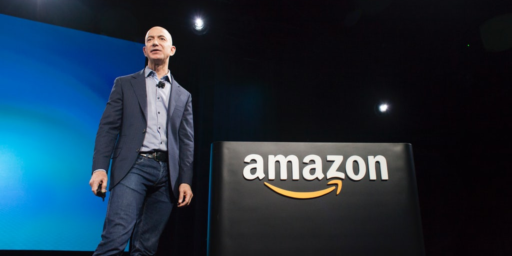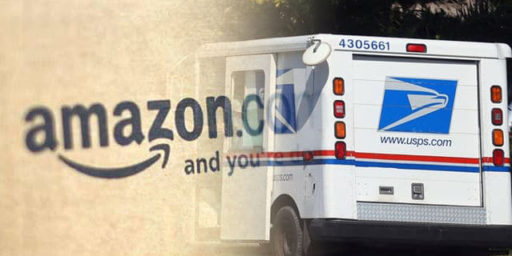The Tech Bubble Has Burst. Or Has It?
A lot of huge investments have failed for a variety of reasons.

The search optimization headline “What’s Behind All Those Tech Layoffs? A New Economic Reality” gives way to “For Tech Companies, Years of Easy Money Yield to Hard Times” once one clicks through on the NYT site.
Eighteen months ago, the online used car retailer Carvana had such great prospects that it was worth $80 billion. Now it is valued at less than $1.5 billion, a 98 percent plunge, and is struggling to survive.
Many other tech companies are also seeing their fortunes reverse and their dreams dim. They are shedding employees, cutting back, watching their financial valuations shrivel — even as the larger economy chugs along with a low unemployment rate and a 3.2 percent annualized growth rate in the third quarter.
One largely unacknowledged explanation: An unprecedented era of rock-bottom interest rates has abruptly ended. Money is no longer virtually free.
Anyone taking the time to read a political blog knows that, in response to levels of inflation we haven’t seen since the early days of the Reagan Administration, the Fed has radically increased interest rates, hiking them seven times in a row with no end in sight. It has manifested most obviously in a housing crash, as the cost of a mortgage went up substantially. But what does this have to do with Carvana?
For over a decade, investors desperate for returns sent their money to Silicon Valley, which pumped it into a wide range of start-ups that might not have received a nod in less heady times. Extreme valuations made it easy to issue stock or take on loans to expand aggressively or to offer sweet deals to potential customers that quickly boosted market share.
It was a boom that seemed as if it would never end. Tech piled up victories, and its competitors wilted. Carvana built dozens of flashy car “vending machines” across the country, marketed itself relentlessly and offered very attractive prices for trade-ins.
“The whole tech industry of the last 15 years was built by cheap money,” said Sam Abuelsamid, principal analyst with Guidehouse Insights. “Now they’re getting hit by a new reality, and they will pay the price.”
But higher rates just means it’s less attractive to borrow more money. Previous loans still cost what they cost at the time they were taken out.
Cheap money funded many of the acquisitions that substitute for organic growth in tech. Two years ago, as the pandemic raged and many office workers were confined to their homes, Salesforce bought the office communications tool Slack for $28 billion, a sum that some analysts thought was too high. Salesforce borrowed $10 billion to do the deal. This month, it said it was cutting 8,000 people, about 10 percent of its staff, many of them at Slack.
Even the biggest tech companies are affected. Amazon was willing to lose money for years to acquire new customers. It is taking a different approach these days, laying off 18,000 office workers and shuttering operations that are not financially viable.
Carvana, like many start-ups, pulled a page out of Amazon’s old playbook, trying to get big fast. Used cars, it believed, were a highly fragmented market ripe for reinvention, just the way taxis, bookstores and hotels had been. It strove to outdistance any competition.
Aha. So, the business model was to lose money, borrow more money, lose more, borrow more, and, finally . . . profit?
The company, based in Tempe, Ariz., wanted to replace traditional dealers with, Carvana said grandly, “technology and exceptional customer service.” In what seemed to symbolize the death of the old way of doing things, it paid $22 million for a six-acre site in Mission Valley, Calif., that a Mazda dealer had occupied since 1965.
Where traditional dealerships were literally flat, Carvana built multistory car vending machines that became memorable local landmarks. Customers picked up their cars at these towers, which now total 33. A corporate video of the building of one vending machine has over four million views on YouTube.
In the third quarter of 2021, Carvana delivered 110,000 cars to customers, up 74 percent from 2020. The goal: two million cars a year, which would make it by far the largest used car retailer.
Then, even more quickly than the company grew, it fell apart. When used car sales rose more than 25 percent in the first year of the pandemic, that created a supply problem: Carvana needed many more vehicles. It acquired a car auction company for $2.2 billion and took on even more debt at a premium interest rate. And it paid customers handsomely for cars.
But as the pandemic waned and interest rates began to rise, sales slowed. Carvana, which declined to comment for this article, did a round of layoffs in May and another in November. Its chief executive, Ernie Garcia, blamed the higher cost of financing, saying, “We failed to accurately predict how all this will play out.”
So, in Carvana’s case, at least, rising interest rates are only a part of the problem. Yes, they were financing what they hoped were short-term losses but the business was actually doing pretty well. Forces outside their control meant they no longer had any product to sell and yet they had massive investments in real estate and an expansive workforce with nothing to do.
Some competitors are even worse off. Vroom, a Houston company, has seen its stock fall to $1 from $65 in mid-2020. Over the past year, it has dismissed half of its employees.
I had literally never heard of Vroom but they are apparently also a used car vendor with a really bad rating with the Better Business Bureau.
“High rates are painful for almost everyone, but they are particularly painful for Silicon Valley,” said Kairong Xiao, an associate professor of finance at Columbia Business School. “I expect more layoffs and investment cuts unless the Fed reverses its tightening.”
Me, too, but are Carvana and Vroom really “Silicon Valley” companies? Aside from having websites and, presumably, phone apps, they’re brick-and-mortar retail outlets, not software firms.
At the moment, there is little likelihood of that. The market expects two more rate increases by the Federal Reserve this year, to at least 5 percent.
In real estate, that is trouble for anyone expecting a quick recovery. Low rates not only pushed up house prices but also made it irresistible for companies such as Zillow as well as Redfin, Opendoor Technologies and others, to get into a business that used to be considered slightly disreputable: flipping houses.
In 2019, Zillow estimated it would soon have revenue of $20 billion from selling 5,000 houses a month. That thrilled investors, who pushed the publicly traded Seattle company to a $45 billion valuation and created a hiring boom that raised the number of employees to 8,000.
Zillow’s notion was to use artificial intelligence software to make a chaotic real estate market more efficient, predictable and profitable. This was the sort of innovation that the venture capitalist Marc Andreessen talked about in 2011 when he said digital insurgents would take over entire industries. “Software is eating the world,” he wrote.
In June 2021, Zillow owned 50 homes in California’s capital, Sacramento. Five months later, it had 400. One was an unremarkable four-bedroom, three-bath house in the northwest corner of the city. Built in 2001, it is convenient to several parks and the airport. Zillow paid $700,000 for it.
Zillow put the house on the market for months, but no one wanted it, even at $625,000. Last fall, after it had unceremoniously exited the flipping market, Zillow unloaded the house for $355,000. Low rates had made it seem possible that Zillow could shoot for the moon, but even they could not make it a success.
Ryan Lundquist, a Sacramento appraiser who followed the house’s history closely on his blog, said Zillow realized real estate was fragmented but perhaps did not quite appreciate that houses were labor-intensive, deeply personal, one-to-one transactions.
“This idea of being able to come in and change the game completely — that’s really difficult to do, and most of the time you don’t,” he said.
Zillow’s market value has now shrunk to $10 billion, and its employee count to around 5,500 after two rounds of layoffs. It declined to comment.
The dream of market domination through software dies hard, however. Zillow recently made a deal with Opendoor, an online real estate company in San Francisco that buys and sells residential properties and has also been ravaged by the downturn. Under the agreement, sellers on Zillow’s platform can request to have Opendoor make offers on their homes. Zillow said sellers would “save themselves the stress and uncertainty of a traditional sale process.”
That partnership might explain why the buyer of that four-bedroom Sacramento house, one of the last in Zillow’s portfolio, was none other than Opendoor. It made some modest improvements and put the house on the market for $632,000, nearly twice what it had paid. A deal is pending.
“If it were really this easy, everyone would be a flipper,” Mr. Lundquist said.
But this isn’t really about the skills necessary to flip houses. The Zillow scheme makes sense it you assume historically low interest rates indefinitely. Their database gave them unique insights into which properties were selling below market value and they had the capital to swoop in and capitalize. It’s just that, with interest rates skyrocketing, their whole premise blew up.
The easy money era had been well established when Amazon decided it had mastered e-commerce enough to take on the physical world. Its plans to expand into bookstores was a rumor for years and finally happened in 2015. The media went wild. According to one well-circulated story, the retailer planned to open as many as 400 bookstores.
The company’s idea was that the stores would function as extensions of its online operation. Reader reviews would guide the potential buyer. Titles were displayed face out, so there were only 6,000 of them. The stores were showrooms for Amazon’s electronics.
Being a showroom for the internet is expensive. Amazon had to hire booksellers and lease storefronts in popular areas. And letting enthusiastic reviews be one of the selection criteria meant stocking self-published titles, some of which were pumped up with reviews by the authors’ friends. These were not books that readers wanted.
Amazon likes to try new things, and that costs money. It took on another $10 billion of long-term debt in the first nine months of the year at a higher rate of interest than it was paying two years ago. This month, it said it was borrowing $8 billion more. Its stock market valuation has shrunk by about a trillion dollars.
The retailer closed 68 stores last March, including not only bookstores but also pop-ups and so-called four-star stores. It continues to operate its Whole Foods grocery subsidiary, which has 500 U.S. locations, and other food stores. Amazon said in a statement that it was “committed to building great, long-term physical retail experiences and technologies.”
Traditional book selling, where expectations are modest, may have an easier path now. Barnes & Noble, the bricks-and-mortar chain recently deemed all but dead, has moved into two former Amazon locations in Massachusetts, putting about 20,000 titles into each. The chain said the stores were doing “very well.” It is scouting other former Amazon locations.
“Amazon did a very different bookstore than we’re doing,” said Janine Flanigan, Barnes & Noble’s director of store planning and design. “Our focus is books.”
I’m not sure this has as much to do with interest rates as hubris. It’s just not a smart business model.
Then again, the loss of “a trillion dollars” in the value of a stock that wasn’t going to be sold is surely overblown.






Back in the junk bond era J.K. Galbraith observed that in times of high and rising inflation any reckless fool can be a great financier. Apparently the high and rising inflation was not required.
I note with trepidation that many sources say inflation’s over, but as noted in one of the quotes above, markets are expecting two more rate hikes. Timing is everything, good and bad.
About 6 months ago The Atlantic had an article to the effect of the end of the millennial subsidy, pointing out that many, not really tech companies, such as Uber, food delivery, Carvana etc were subsidizing the cost of their products with the money of investors. Rising interest rates dried up those investments and these companies were left with investors who wanted, profits.
True tech companies went on a hiring binge during Covid and now are suffering because advertising revenue has cratered. Speculative investments in risky new products are being cutback and many high growth companies such as the FAANGs are no longer youthful, high growth companies disturbing existing marketplaces. But are now maturing middle age companies that themselves are subject to disturbance from upstarts.
As long as interest rates are high money will go to safer investments, but once they are back down that money will return to tech stocks, as there is nothing else that could turn a small fortune into a big one, quickly.
My suspicion is that the Fed will raise interests rates or hold steady for a few more months at most. It takes many months for such action to affect the economy and I think they have hit it way too hard, and we will be in serious trouble by summer. While the press mostly focuses on annual inflation, the trend by month has been sharply down. If you took Decembers inflation rate and annualized it, Core would be 1.6% and Headline would actually be negative (due to plunging energy prices). Yet the Fed continues to whack the economy with their big stick.
Most tech companies strategy was to run at a loss to buy market share until network effects became strong enough that they were in a position to start charging monopoly rents.
In an aviation podcast I listed to years ago, one of the podcasters liked to use the phrase “chasing market share off a cliff.” It might not be so for airlines, but apparently it’s what tech (as well as “tech”) companies do.
Tim Harford’s latest Cautionary Tales ep was about speculative bubbles. Alas, Mr, Harford is losing a bit of his touch. He set up the background well enough with the Dutch mania for tulips, and the mania in Britain for railways, but failed to even say why shares in start-up railways collapsed in the mid 1800s.
Cheap money and leverage can hide many sins and incoherences (it should be noted for the factual record that the journalistic stereotype of what Amazon did – lose money until they didn’t via massive growth – is actually wrong. Amazon had from early stages operating lines that were organically profitable on their own. They were not losing money directly on core lines, rather they plowed into new areas for scale.
In effect, free money is rather more subsidising to speculative capital than it is to general economic actors, so while the Left reflexively moans on about any action by the Fed, a return to more historically normal rates in long-run terms is rather better overall for the general interest than a continuation of the eccentric era of zero following 2008.
@MarkedMan: monthly variation of headline nor core alone is not how we look at this in central bank terms and as the 1970s proved with several phases of fade and rebound (or Turkey doing more or less what the Lefties desire Fed or ECB to do), simplistic headline driven policy is unwise.
@gVOR08:
That’s partly because high an rising inflation, if interest rates lag, can be approximated by a prolonged period of ultra-low interest rates, even if inflation is low, so long as the very low inflation is ahead of the very low interest for long enough.
Lots of money in the system, all seeking maximised returns where “ordinary” investment yield very little.
Recipe for fermentation breeding bubbles.
That’s the business model for many tech companies – lose money until scale makes them profitable. Sometimes that never happens. Amazon’s eCommerce business lost money for years and years, and Amazon revenue and profits are still highly dependent on AWS, for example.
@Lounsbury:
True, and I recognize that this is a bit of unknown territory since one of the primary drivers is a black swan event. But the trend since last year has been down, with Core PPI going below 5% (annualized) last July and continuing to trend down. CPI also went below 5% (annualized) in the same month, and while it is even more volatile, has not gone back above and was actually slightly negative for December. Yet the Fed keeps hitting rates with its hammer. Given that the shortest “Fed Raise to Economic Impact” length I’ve ever seen is 7 months, this just strikes me as excessive.
I don’t pretend to be a financial expert and am just speaking from my experience of watching 6 decades worth of economic cycles.
@MarkedMan:
Because Biden left a bunch of Trumpists in charge of the fed and they’re trying to tank the economy to help their political allies
Might be a good time to bring up the fact that operations like Uber and Lyft (and other “tech” companies) are still in the red. They didn’t replace Taxies, they just did what others have been doing since forever. They are “Gypsy Cabs” with a smart phone app. I think Caravan and outfits like it might just be another “great idea” that really isn’t all that great.
Cheap money is drying up regardless of the Fed. The market is full of retirement savings for Boomers who will now move to safer investments or consumption. Plus inflation sucks cash out of savings. Even after adaptation, GenX is a smaller cadre who as a whole won’t be putting as much money in the market as the mass of Boomers.
Social media companies will trim since they hired a lot of non-essential workers to fill fancy offices that will now eat them alive. Musk has shown the way with Twitter. Hard tech will have problem with getting chips. All the low end consumer product chips are from China and that is going to be a tough haul. High end chips are still in the US, but cars, toasters, etc. run of jellybean 8 or 16 bit chips whose fabs were long ago moved to China. But China has an aging problem.
@JKB:
Twitter’s revenue is down 40% YoY, but sure, that’s the guy you want to copy.
@Andy: In re
As I noted this is partially a myth based on an oversimplified top level financials. Fundamental financials on Amazon, their loss-making was from constant expansion on new business lines/sub-lines, while in fact core was turning to non-loss-making on standalone basis. This mythology however has laid the foundation for foolish bets (like Uber, Lyft, delivery services) taht took the top-level without understanding and thus even their core service is fundamentally loss-making and impossible to ever actually be profitable.
@MarkedMan: I wil simply observe from having spent a decade in central bank committees and related activity that the econometrics used inside do not resolve down to such numbers alone. And the lessons of the ‘stagflation” era (of roughly 69-83 depending on your country, etc) – the entire decade, not merely the spikes taught lessons.
Inflation persistance is rather more dangerously corrosive for your agendas than a modest central bank recession.
Counting as personal acquitance several of your senior fed people, the partisan attacks from left now and earlier right when Fed was not pleaseing Trumpies are deeply unmerited.
@Stormy Dragon: No Biden did not leave a bunch of Trumpists in charge, that is a profoundly ignorant tripe of pure dimwitted kneejerking conspiracy minded partisanship. Powell & Co are professionals. Ms Brainard, Ms Cook, Mr Jefferson, Mr Barr, none of whom are Republicans are serious central bank professionals – and not party political partisans. – you can profitably count then the weighting amongst the governing body and then reflect on innumeracy and partisan knee jerking. The only thing exceeding this comment in dim partisan foolishing is of course JKB nonsensical partisan bleating
@JKB:
If the way is of course blundering incompetence and senseless and needless value destruction in the service of foolish petty personal concerns and passing empty politial posturing. – althought that is more standard for Bolshevik management than proper business. However you seem to be fundamentally into a form of inverted Bolshevism.
@Rick DeMent: Analyses going back roughly to their first years IDed that there was no rational economic case for the founders pretence at the ‘drive everyone out of business to have monopoly power or oligopoly power’ was market-structure non-sensical lacking an actual understanding of the transport business.
Which I have to say is what I have seen far too often from both VCes and Entrepreneurs who have lived in the software and apps world and have a high degree of Magical Thinking with respect to how things happen. As an investor in real world physical logistics operations (my other area besides renewable energy), I find these people maddening.
It’s quite a coincidence that so many profitable tech companies have simultaneously discovered that they have 6-8% too many workers.
Google, Facebook, Microsoft and Amazon are doing basically fine. Sitting on piles of cash, stock buy backs, huge profits last year.
There are other companies that just make no sense (Uber, Lyft,…) that are running on credit and can’t afford to burn at the same rate anymore, but the layoffs going through the stable tech companies are strange, as if they are just hopping on the bandwagon.
Or they are going Galt, just a little bit, trying to get the employees to recognize the greatness of the capital class, or just break the high wages caused by their previous hiring sprees.
On the Musk & Twitter front, lest one think that is it some Lefty view that Musk has been grossly incompentent, from The Financial Times, on Musk in contrast with Arnault, bastion of the barons of capital (not the barrons of pillow selling or sad real estate pretence)
It is no Lefty pretence that Musk has been grossly incompetent nor is the global market massacre an explanation as all of us in proper capital investment see clearly.
Only innumerate political partisans can fool themselves otherwisse, Musk i s the very model of how not to succeed in these particular tech spaces – pity really as had he not become apparently sucked into sterile foolishness of partisan party politics distracting from real business….
@JKB:
Even if that were true, he would be doing it at the expense of Tesla. Tesla’s stock has dropped so much since Musk started his Twitter fiasco that he has wiped out 14 Twitters of market cap at Tesla.
@Gustopher:
I don’t suppose the God Emperor of Mars and Phobos will be the first person to ruin two companies in this peculiar way, but he’ll certainly be the first to do so on social media 24/7.
Profit? Why bother with that?
Seriously, there’s a whole segment of the startup space that is less about delivering products to customers than delivering dreams to investors. The investors arethe paying customers.
And then there’s another segment where the exit plan isn’t to create a profitable company, but to get bought out by a bigger company. The goal is less to be profitable than to appear compelling and attractive and buyable. To get someone to say “with the marketing power of MegaCorp, this could truly be a success!”
If you get paid well, and have more money than when you started, did the business really fail just because it went bankrupt? The business successfully transferred wealth from investors’ pockets into the owners’ and employees’ pockets.
Is it a grift? Maybe.
Yah there’s a lot of Silicon Valley start-ups where the business plan seems to be: (add $ from investors to keep going) (add $ from investors to keep going)(get bigger)(purchase another company with more investor $)……(add AI+blockchain)(mumble mumble network efficiencies)…..(profit?).
And there’s enough dumb money chasing unicorns that this can go on for a long, long time.
(P.S. Doesn’t anyone remember the first dot-com fiasco?)
@Stormy Dragon:
He’s reduced payroll and associated expenses by 70-75%, so the net might be worth it. Of course, he’ll never make the interest payments that way but he appears to be running a charity over there.
I’m curious where you saw that 40% number though? They are private now and so don’t have to report numbers.
@Lounsbury:
That is good to hear. I admit my concern is more based on agita rather than any financial theory. And the fact that the people in charge are most concerned with keeping their peers (i.e. the financial movers and shakers) happy, and only mildly concerned with keeping a working stiff employed.
@Stormy Dragon, @Lounsbury:
Interesting. When I first read JKB’s comment, I was reading it as a cautionary rather than an exemplary action, that is that Musk is showing the way to the same sort of destruction that other enterprises are experiencing. Of course, I never take anything that JKB provides as an example as a credible way to theorize, so maybe we’re on two sides of one coin after all.
@Lounsbury, @Gustopher: To some degree, I think that Musk may well be “show[ing] the way” in that he may well be revealing that what other quasi-tech entities were doing is sort of like the Underwear Gnomes of South Park fame:
.
@Gustopher: “The investors are the paying customers.” [corrected for format]
OOHHHHHH! Great call Gus! (You don’t mind if I call you “Gus” for short, do you?) You may have nailed the missing idea in all this–that it’s the same basic ploy as various software and web services needing “a plan for Amazon/Microsoft/Google to buy them out” substituting VCs for AMG. Interesting!
@grumpy realist: “(P.S. Doesn’t anyone remember the first dot-com fiasco?)”
That was the first thing I thought of when I read the headline. (F**k, I’m sure getting old. 🙁 )
@Gustopher:
@Just nutha ignint cracker:
Back in the late 90s, a cousin started an internet company consisting in a free lottery. I forget the mechanics, but you got a number of picks per day and there was one drawing. You could win real money, albeit not much, and prizes were paid.
His business model was “We’re hoping to be acquired by a larger company.”
I recall a site around those times which did the same thing, called Freelotto. The time to get the daily picks was brief, so I entered almost every day. I won a few small prizes (around US $10-$25). They had adds, eventually the annoying pop-up ads, and didn’t last long.
There were other sites offering free stuff, too. iname.com, netaddress, and Amexmail (shaky on that last name) offered free email. Geocities hosted websites for free (I had one briefly; book reviews).
I think they’re all gone. But some might have been acquired by a bigger company.
@Just nutha ignint cracker: Yeah, “build to flip” is an established description of tech companies as early as 2000. It’s not even a secret.
@Gustopher:
It’s factoids like this that have me seriously considering if the secret to being a rich investor is more an accident of fate and birth than anything else.
@Rick DeMent: You misunderstand the tech investment market. Unless the start-ups have raised High-Net Worth individuals money – most typically done in form of “Angel investing” in spreading some relative pocket-change around in seeding some early effort, “rich investor” as you are understanding “rich guy” has little to do with this market.
It is typically Venture Funds whose investors are Qualified Investors – that is institutionals, largely retirement portfolios as pensions – who are desperately seeking to goose their returns since Fixed Income has become a disaster with negative yields – a side effect of the era of zero interest money – not merely through debt as you all are thinking, bank loans, but also via retirement and insurance placements desperately seeking returns.
And then the venture managers throw around trying to find some big wins Too much hot money.
@Just nutha ignint cracker: Twitter was weak but it had actual profitable moments and perhaps with some more discipline could have been better. That is completely different economics from Uber, Lyft, the delivery apps whose fundamental delivery economics are operationally loss making and sans market power (monopoly power) that is defensible to enable ratchet on pricing (which even if one imagined somehow would occur in any politically sustainable/defensible fashion) the pricing needed would destroy demand. Basic operational economics…. any proper investor knew this and was making a bet on “off-load” the bet on the public market, unwashed masses….
@Lounsbury:
Grin.
Well after that explanation I’m more convinced than ever that being rich in general is an accident of fate and birth more than anything else.
@Rick DeMent: Your conviction has rather little to do with being convinced by my explanation then, being either preformed prejudice or miscomprehension, as personal wealth has very little to do with the tech market, wheres massive reitrementment funds like the California teachers retirement fund and similar, are actual drivers – along with zero bound interest rates.
With regard to “Musk has shown the way”, and the following jeering.
I think it is way, way too early to judge whether Musk’s changes are a success or a failure. They are an idea, which might get copied. They are still in a very, very early stage. We will know better a year from now, and even better two years from now.
I think it’s very likely that Musk anticipated the drop in revenue, or at least some drop in revenue. Why else make this a private equity play?
And yeah, if you used Twitter you’re unhappy, and I don’t blame you.
@Jay L Gischer: jay, there is no proof that he has a plan beyond the world’s most expensive mid-life crisis.